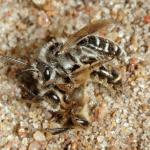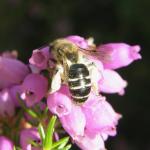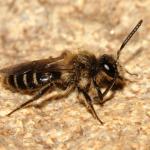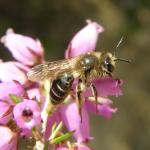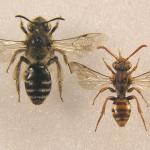This small to medium-sized Andrena is strongly associated with loose, dry sandy soils in open, heathy situations. The females are quite colourful when fresh, but soon become dowdy. The males, which race over the surface of loose sand in the sun, wear out even more quickly and a bright silver-grey insect rapidly becomes a dull browny-black with few obvious hairs. It is closely related to the similar, but larger and spring-flying, Andrena barbilabris (Kirby). Although not restricted to visiting ericaceous flowers, the heathland flowering period suits this species very well, providing ample floral resources close to suitable nesting habitat.
This species occurs in England and has a strongly south-eastern distribution, but has increased its range recently. There are also records from the Channel Islands.
Despite its very southerly distribution in Britain, it is a northern and central European species.
This species is listed in Falk (1991) as Nationally Notable/Na (now known as Nationally Scarce).
Associated with dry, warm habitats on sandy soils, most often ericaceous heathland. It has also been found in less typical locations in West Sussex, such as in a woodland clearing, although still within a sandy area.
July to August.
Small nesting aggregations occur in loose sandy soil in sunny places, often using quite well-churned paths. The females allow the burrow to collapse behind them as they enter and leave, possibly hiding the entrance. The actual nest is made in the firmer sand underneath, so excessive soil disturbance is damaging to the nests.
A range of flowers, including umbellifers, heathers and tormentil.
Nomada baccata (Smith) is the special cleptoparasite of this bee.
2016


